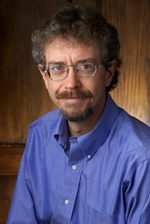|
|
 |
 |

Faculty Lecture Series
When |
Wednesday, January 12, 2011
5 PM - 6 PM |
Where |
Valerie Timken Amphitheater
Green Hospital |
Who |

|
James R. Williamson, Ph.D.
Professor
Departments of Molecular Biology and Chemistry
The Skaggs Institute for Chemical Biology
Dean, Kellogg School of Science and Technology
|
Topic |
"Ribosome Assembly: Systems Biology of the Core Machine" |
| |
The bacterial 70S ribosome is the macromolecular machine responsible for synthesis of all cellular proteins. Biogenesis of ribosomes, which is composed of three large RNA molecules and over fifty small ribosomal proteins, accounts for about one third of the energy budget of a rapidly growing cell. The process of ribosome assembly must be efficient and coordinated, and the stoichiometric production of all of the components is tightly regulated permitting growth under a wide range of conditions. Efficient in vitro assembly reactions for the 30S and 50S ribosomal subunits have mapped the thermodynamic dependencies for ribosomal protein association, resulting in the so-called Nomura and Nierhaus assembly maps, respectively. In our laboratory, we have been developing techniques to allow us to measure the kinetics of assembly in vitro. We have developed an isotope pulse chase assay, using 15N-labeled ribosomal proteins, that measures the rates of binding of all 20 small subunit ribosomal proteins to 16S rRNA simultaneously. The method takes advantage of quantitative analysis of 14N and 15N proteins using mass spectrometry. We have used this assay to measure the rates of binding of proteins under a variety of conditions, and in the presence of ribosome assembly factors.
Most recently, we have adapted our quantitative mass spectrometry approach to monitor ribosome biogenesis directly in rapidly growing bacterial cells. A pulse of 15N medium into a culture labels the newly synthesized ribosomal proteins and assembly intermediates more rapidly than fully assembly ribosomes. Quantitation of the flux of the isotope label reveals kinetic information on the biogenesis process. We can identify a range of assembly intermediates for the 30S and 50S subunits, and quantitatively analyze the ribosomal protein content of the intermediates. In addition, we can perform proteomic studies to identify the presence of assembly cofactors associated with these intermediates. In addition, we are exploring the role of these cofactors in ribosome assembly using deletion strains and over-expression approaches. We are trying to synthesize information from all of the in vitro and cell-based approaches into a mechanistic framework for studying ribosome assembly.
|
|
| |
|
| |
|
| |
|
| |
|
| |
|
|
 |
|
|



